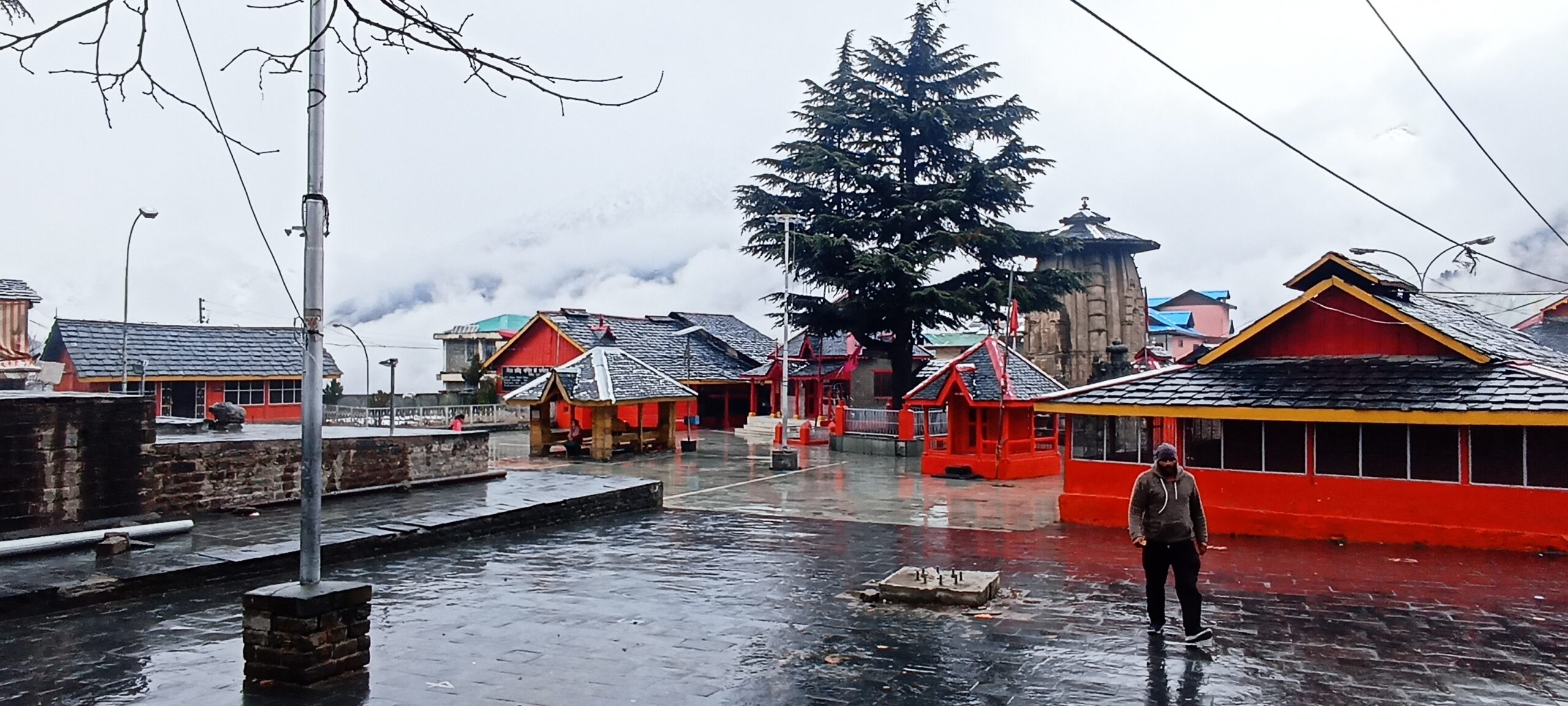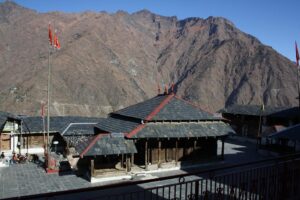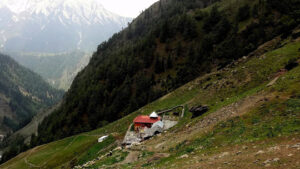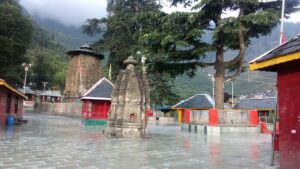
Chaurasi temples (84 Temples) are located in the center of Bharmour town and it holds immense religious importance because of temples built around 1400 years ago. Life of people in Bharmour centers around the temple complex-Chaurasi, named so because of 84 shrines built in the periphery of Chaurasi Temple. Chaurasi is hindi word for number eighty four. The beautiful shikhara style temple of Manimahesh occupies the center of the complex. It is believed that when 84 Siddhas, who had come from Kurukshetra, were passing through Bharmour to visit Manimahesh, they fell in love with the calmness of Bharmour and reconciled to meditate here. Chaurasi Temple Complex was built approximately in 7th century, although repairs of many temples have been carried out in later period.
There is another legend associated with Chaurasi temple complex. It is believed that shortly after Sahil Varman’s rise of Brahampura (ancient name of Bharmour), 84 yogis visited this place. They were greatly pleased with the King’s hospitality. As King had no heir, Yogis promised him ten sons. They were requested by the King to stay back in Brahampura till the prediction of Yogis was fulfilled. In due course of time the king was pleased with ten sons and a daughter. Daughter was named Champavati and because of liking of Champavati new capital Chamba was established. It is believed that Chaurasi temple complex in Bharmour was built to honour these 84 Yogis and named Chaurasi after them. There are 84 big and small temples in Chaurasi temple complex. Chaurasi is a spacious level ground in center of Bharmour where the galaxy of temples mostly in the form of Shivlingas exists. The Chaurasi Temple Complex offers a enjoyable, clean and a lovely view.
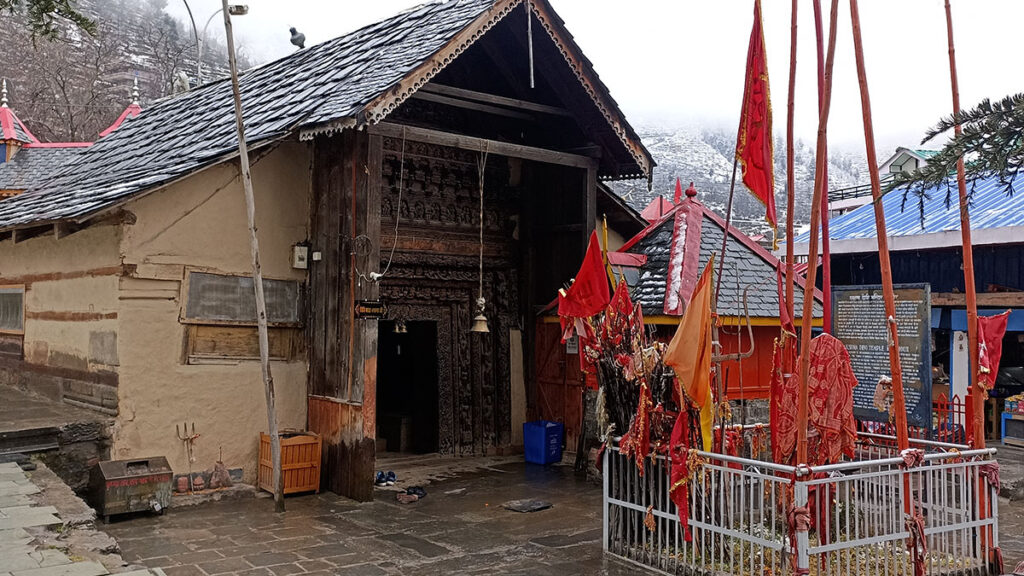
Major Temples in the complex
- Lakshana Devi Temple (Lakhna Devi/Mahishasuramardini): The temple of Lakshana Devi is the oldest temple at Chaurasi Temple Bharmour. It retains many of the old architectural features of wooden temples and has richly carved entrance. It is said to be constructed by Raja Maru Varman (680 AD). Durga is represented here in her aspect of four armed Mahishasuramardini, the slayer of the demon Mahishasura.
- Manimahesh (Shiva) Temple: Manimahesh temple which stands in the centre of Chaurasi temple, is main temple, enshrining a huge Shiva linga. The Shiva linga is nothing but a symbol of characteristic mark of lord Shiva and is worshiped in a symbol.
- Narsingh (Narasimha) Temple: Narasimha (Sanskrit: Narsingh) or Nrusimha, also spelled as Narasingh whose name literally translates from Sanskrit as “Man-lion”. Narasimha is an incarnation of Vishnu in which the god is represented in therianthropic form as half man and half lion. The bronze image of this god, which is exquisitely cast, is awe-inspiring.
- Lord Nandi Bull Temple: The life size metal bull Nandi, locally known as Nandigan with the broken ear and tail can be seen standing in a modern shed in front of Manimahesh temple. Nandi is chief of Ganesh and Shiva’s foremost attendant, who had shape of the bull and qualities of noble devotee. Usually in front of Shiva temples the Shilpa Texts provide for a couchant bull paced outside and staring at his lord Shiva. But here we have a life size Nandi bull standing on all fours (legs). ‘Visnudharmotra Purana’, however describes of such Nandi bull, as representing solidity and stability of dharma.
- Dharmeshvar Mahadev (Dharamraj) Temple: Dharamraj, known as Dharmeshvar mahadev was given a seat on the northern corner of Chaurasi by Maru Varman. It is the belief of locals that every departed soul stands here to seek final permission of Dharamraj to proceed ahead and travels through this temple after death seeking dwelling in Shiva Loka. It is believed to be the court of Dharamraj and is locally called ‘dhai-podi’, which means two and half steps.
- Ganesh or Ganpati Temple: Lord Ganesha temple is situated near the entrance of Chaurasi temple, Bharmour. The temple was constructed by the rulers of the Varman dynasty as stated in an inscription erected in the temple, by Meru Verman in circa 7th century A.D. The wooden temple of ganesha was probably set on fire in Kira invasion of Bharmour and image was mutilated by cutting off legs. The temple of Ganesha is enshrined in a bronze image of Ganesha. This magnificent image is life size with both legs missing.
- Swami Kartikeya temple: The Swami Kartikeya Temple, also known as Kelang Temple, is located on the right side of the entrance to the Lakshana Devi Temple in the Chaurasi Temple Complex, Bharmour. It features an upright stone symbolizing Kelang, the god of war, and a carved wooden figure offered by a devotee. A six-inch high metal idol with two arms holding a staff and ring also represents Kelang. Recently, a marble image of Kartikeya Kelang has been added. Kelang, revered as Kartik-swami by locals, is widely worshipped in Bharmour, with many temples dedicated to him in the area. The most famous is the Kartikeya Temple near Kugti. Locals also build small Kelang temples in their homes.
Myths and Legends

It is believed the land was firstly watched by goddess Bharmani Devi. One day 84 Siddhas, who had come from Kurukshetra, were passing through Bharmour to visit Manimahesh along with Lord Shiva. He asked Bharmani Devi if they could take shelter for the night at Bharmour. Bharmani Devi allowed them but the next day when she woke up she saw smoke and fire. She saw that the 84 siddhas had settled on her land. Angry at this trespassing she ordered Shiva and the siddhas to get out of the place as she believed that now the people would pray to Lord Shiva and her level of importance would fall. Shiva importuned in all his humility and to console Bharmani Devi he said “whoever comes to Manimahesh first had to take a dip in the pool of Bharmani Devi then only the yatra will be completed”. To this Bharmani Devi went to the ridge of Bhudhal valley and from there at any point no one can see the Chaurasi temple. Lord Shiva left but the 84 siddhas transformed themselves into 84 Shivlingas as they fell in love with the calmness of Bharmour and reconciled to meditate here.

